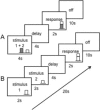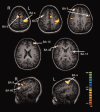Crossmodal influences in somatosensory cortex: Interaction of vision and touch
- PMID: 19572308
- PMCID: PMC6870919
- DOI: 10.1002/hbm.20841
Crossmodal influences in somatosensory cortex: Interaction of vision and touch
Abstract
Previous research has shown that information from one sensory modality has the potential to influence activity in a different modality, and these crossmodal interactions can occur early in the cortical sensory processing stream within sensory-specific cortex. In addition, it has been shown that when sensory information is relevant to the performance of a task, there is an upregulation of sensory cortex. This study sought to investigate the effects of simultaneous bimodal (visual and vibrotactile) stimulation on the modulation of primary somatosensory cortex (SI), in the context of a delayed sensory-to-motor task when both stimuli are task-relevant. It was hypothesized that the requirement to combine visual and vibrotactile stimuli would be associated with an increase in SI activity compared to vibrotactile stimuli alone. Functional magnetic resonance imaging (fMRI) was performed on healthy subjects using a 3T scanner. During the scanning session, subjects performed a sensory-guided motor task while receiving visual, vibrotactile, or both types of stimuli. An event-related design was used to examine cortical activity related to the stimulus onset and the motor response. A region of interest (ROI) analysis was performed on right SI and revealed an increase in percent blood oxygenation level dependent signal change in the bimodal (visual + tactile) task compared to the unimodal tasks. Results of the whole-brain analysis revealed a common fronto-parietal network that was active across both the bimodal and unimodal task conditions, suggesting that these regions are sensitive to the attentional and motor-planning aspects of the task rather than the unimodal or bimodal nature of the stimuli.
2009 Wiley-Liss, Inc.
Figures





Similar articles
-
Crossmodal influences on early somatosensory processing: interaction of vision, touch, and task-relevance.Exp Brain Res. 2013 May;226(4):503-12. doi: 10.1007/s00221-013-3462-z. Epub 2013 Mar 3. Exp Brain Res. 2013. PMID: 23455852
-
Task-relevance and temporal synchrony between tactile and visual stimuli modulates cortical activity and motor performance during sensory-guided movement.Hum Brain Mapp. 2009 Feb;30(2):484-96. doi: 10.1002/hbm.20520. Hum Brain Mapp. 2009. PMID: 18095277 Free PMC article.
-
The attentional-relevance and temporal dynamics of visual-tactile crossmodal interactions differentially influence early stages of somatosensory processing.Brain Behav. 2014 Mar;4(2):247-60. doi: 10.1002/brb3.210. Epub 2014 Jan 23. Brain Behav. 2014. PMID: 24683517 Free PMC article.
-
Speech map in the human ventral sensory-motor cortex.Curr Opin Neurobiol. 2014 Feb;24(1):63-7. doi: 10.1016/j.conb.2013.08.015. Epub 2013 Sep 12. Curr Opin Neurobiol. 2014. PMID: 24492080 Free PMC article. Review.
-
Distributed neural networks of tactile working memory.J Physiol Paris. 2013 Dec;107(6):452-8. doi: 10.1016/j.jphysparis.2013.06.001. Epub 2013 Jun 17. J Physiol Paris. 2013. PMID: 23792021 Free PMC article. Review.
Cited by
-
The interplay of cue modality and response latency in brain areas supporting crossmodal motor preparation: an event-related fMRI study.Exp Brain Res. 2011 Sep;214(1):9-17. doi: 10.1007/s00221-011-2745-5. Epub 2011 Jun 9. Exp Brain Res. 2011. PMID: 21656217
-
Neural Basis of Anticipatory Multisensory Integration.Brain Sci. 2021 Jun 25;11(7):843. doi: 10.3390/brainsci11070843. Brain Sci. 2021. PMID: 34201992 Free PMC article.
-
Crossmodal influences on early somatosensory processing: interaction of vision, touch, and task-relevance.Exp Brain Res. 2013 May;226(4):503-12. doi: 10.1007/s00221-013-3462-z. Epub 2013 Mar 3. Exp Brain Res. 2013. PMID: 23455852
-
Phantom Acupuncture Induces Placebo Credibility and Vicarious Sensations: A Parallel fMRI Study of Low Back Pain Patients.Sci Rep. 2018 Jan 17;8(1):930. doi: 10.1038/s41598-017-18870-1. Sci Rep. 2018. PMID: 29343693 Free PMC article.
-
Alice in Wonderland Syndrome: A Clinical and Pathophysiological Review.Biomed Res Int. 2016;2016:8243145. doi: 10.1155/2016/8243145. Epub 2016 Dec 27. Biomed Res Int. 2016. PMID: 28116304 Free PMC article. Review.
References
-
- Allison T, McCarthy G, Wood CC ( 1992): The relationship between human long‐latency somatosensory evoked potentials recorded from the cortical surface and from the scalp. Electroencephalogr Clin Neurophysiol 84: 301–314. - PubMed
-
- Alsius A, Navarra J, Campbell R, Soto‐Faraco S ( 2005): Audiovisual integration of speech falters under high attention demands. Curr Biol 15: 839–843. - PubMed
-
- Alsius A, Navarra J, Soto‐Faraco S ( 2007): Attention to touch weakens audiovisual speech integration. Exp Brain Res 183: 399–404. - PubMed
-
- Andersen RA, Snyder LH, Bradley DC, Xing J ( 1997): Multimodal representation of space in the posterior parietal cortex and its use in planning movements. Annu Rev Neurosci 20: 303–330. - PubMed
-
- Andersen SK, Hillyard SA, Muller MM ( 2008): Attention facilitates multiple stimulus features in parallel in human visual cortex. Curr Biol 18: 1006–1009. - PubMed
Publication types
MeSH terms
LinkOut - more resources
Full Text Sources

